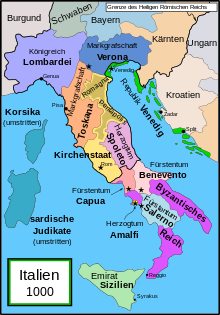Pandulf I.
Pandulf I (called Eisenkopf , Latin Capiferreus ) († 981 ) was Prince of Capua and Benevento and, as an ally of Otto I, acquired the duchies of Spoleto , Camerino and the Principality of Salerno .
Life
He came from a Longobard family. His father was Landulf II (also counted as Landulf IV). One brother was Landulf III. (or Landulf V.) He himself married Aloara around 950/55, who died in 992. Several children were born from the marriage.
Together with his father he ruled Benevento and Capua since 943. From 959 the brother Landulf also took part in the government. After the death of their father in 961, the brothers initially ruled collectively. She later shared the rule. Pandulf reserved the supremacy for himself.
Pope John XII probably undertook a campaign against Capua against Pandulf I and Landulf III after the death of his father Landulf II. The Pope was allied with Theobald II of Spoleto , who endeavored to get back lost territories. The campaign was a failure.
Pandulf leaned firmly on Otto I. In 965 he had envoys from the Antiottonian Pope John XII. captured at the imperial court in Constantinople and handed over to Otto.
When Pope John XIII. was expelled from Rome by the population, Pandulf granted him asylum. As thanks for the support of the pope who was close to the emperor, Otto I. Pandulf handed over the margravates of Spoleto and Camerino, which belonged to the northern kingdom of Italy . Conversely, Pandulf entered into a vassal relationship with Otto for Capua and Benevento. By connecting with Pandulf, the emperor wanted to strengthen his position in southern Italy. The Pope made Benevento the first archbishopric in Campania in 969 . A brother of the prince became archbishop. Two years later, Capua also became the seat of an archbishop .
After the death of his brother Landulf in 967/968, he appointed his own son Landulf as co-regent in Benevento without giving up the actual rule.
Pandulf supported Otto in the war against the Byzantines in 968. After Otto had left southern Italy, Pandulf continued the fight alone, but was wounded and temporarily captured and brought to Constantinople. After the capture, the Byzantines went on the offensive and besieged Capua, among other things, before they withdrew for fear of Otto's intervention. After the emperor Johannes Tzimiskes came to power , Pandulf was able to return to Italy.
When Gisulf I of Salerno was expelled from the population, Pandulf helped him regain power. For this he and his son were promised the successor in Salerno. This increase in ownership meant that Pandulf ruled the area from Ancona to Calabria between 974 and 981. His area thus formed an important buffer zone between the power of Otto and that of the Byzantines. After his death, his possessions were divided. Salerno and Spoleto were completely lost to his family and Capua and Benevento were divided among their descendants and relatives.
Remarks
- ↑ RI II, 5 No. 281 , in: Regesta Imperii Online (accessed December 11, 2012)
- ^ Wolfgang Huschner: Benevento, Magdeburg, Salerno. The papacy and the new archbishopric in Ottonian times. In: The Papacy and the Diverse Italy: One Hundred Years of Italia Pontificia. Berlin 2009, p. 99.
- ^ Hagen Keller , Gerd Althoff : The time of the late Carolingians and the Ottonians 888-1024. Stuttgart 2008, p. 214.
- ^ Wolfgang Huschner: Benevento, Magdeburg, Salerno. The papacy and the new archbishopric in Ottonian times. In: The Papacy and the Diverse Italy: One Hundred Years of Italia Pontificia. Berlin 2009, p. 99; RI II, 5 No. 393, in: Regesta Imperii Online (accessed December 11, 2012)
- ^ Matthias Becher: Otto the Great: Emperor and Empire. Munich 2012, p. 249; RI II, 1 No. 501a, in: Regesta Imperii Online (accessed December 11, 2012)
- ^ Hagen Keller, Gerd Althoff: The time of the late Carolingians and the Ottonians 888-1024. Stuttgart 2008, p. 258.
literature
- Christopher Kleinhenz: Medieval Italy: An Encyclopedia. Vol 2. London 2004, p. 843.
Web links
- Entry in Medieval Lands (en.)
- Entry on treccani.it (it.)
- Entry on Prosopography of the Middle Byzantine Period online
| personal data | |
|---|---|
| SURNAME | Pandulf I. |
| BRIEF DESCRIPTION | Prince of Capua and Benevento |
| DATE OF BIRTH | 10th century |
| DATE OF DEATH | 981 |
